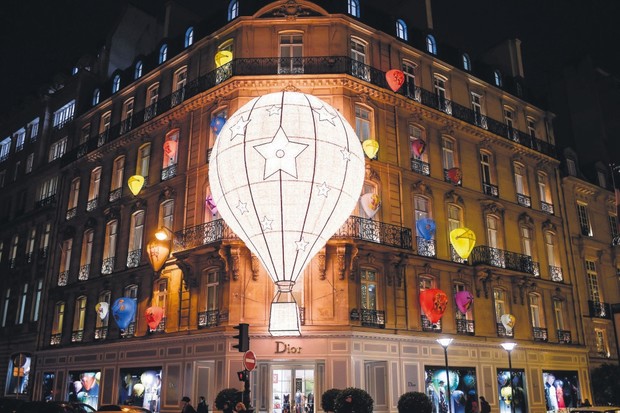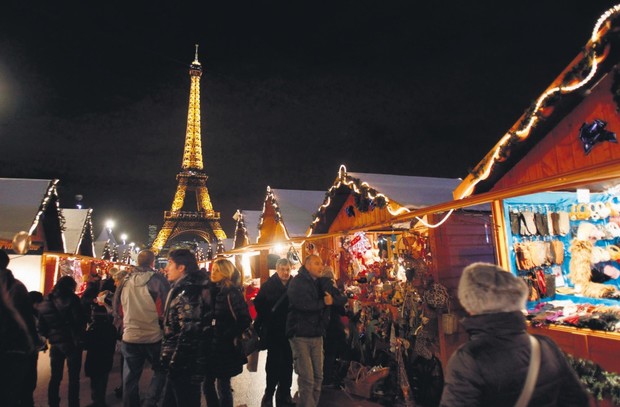© Turkuvaz Haberleşme ve Yayıncılık 2024
Of course Paris draws visitors from all over the world for its art and culture, of course. Paris museums and architecture and haute cuisine are always going to be around. You can go to the Louvre and stand in line to see the Mona Lisa. A way more fun option would be to participate in winter festivities available only around this time of year. Parisians love a good winter holiday celebration.
Any good winter vacation needs to have a good balance of warm and cold – of inside things and outside things. The outside things are public and wacky and fun, and make you long for the comfort of inside things as soon as possible. Here's a list of great Paris holiday activities, starting from outdoors to mostly in.

Window shoppıng and Christmas lights
Paris even at non-Christmas times of year is known as the City of Lights. During Christmas is when they try to win that title for the next year (nice try, Belarus – Minsk stays the City of Dims for 2018). Major thoroughfares and huge department stores spend thousands of euros to drape sheets of fairy lights over every conceivable surface. Huge chandeliers of light hang above the streets. Buildings turn into suns. Streetlights turn into light-tubes. Trees turn into rocket ships. It's like a European Las Vegas, but with less Lady Gaga. The famous Champs Elysees is of course decked out until it becomes a glittering nightmare, but I think perhaps this year you should visit Boulevard Haussman. A famous avenue in its own right due to the presence of the department store Galerie Lafayette, this year they've given design powers to the public. You can download the PlayHaussman app on your phone and design your own light displays to be shown on the boulevard. I have no idea how this will play out. Is there a queue? Do the flashing lights change immediately upon upload of a new design? Is it Christmas chaos? Either way you should take a look.
Secondly, department stores all throughout Paris create hugely elaborate constructions in their windows. Carnivals in miniature or animatronic nativity scenes featuring dinosaurs, or Rube Goldberg Christmas-y contraptions are all popular. The French phrase for "window shopping" translates to "window licking," and you'll definitely want to get close enough to the window displays to lick the glass.
Christmas markets in the city
I'd be remiss if I didn't mention the many Christmas markets throughout the city. The Christmas market tradition started in Germany sometime in the 1400s, when vendors came together to sell sweets, toys, breads and vin chaud. Today holiday markets pop up all over Europe, and Paris has some of the best. You can find any number of holiday bazaars full of snacks, drinks and wintry goods for sale. Vendors set up a wooden kiosk in a public square and spread whatever version of Christmas cheer they've got on tap.

Imagine my surprise when I realized the Christmas market at Champs Elysees was not the only Christmas market in town. Nor is it even the largest. The market at La Defense boasts more than 300 stalls with whole hanging ham hocks and carnival games. At Champ de Mars, just underneath the Eiffel Tower, you can go ice-skating or go up to the tower itself where there's another ice skating rink with a view. Gar de l'Est features a market of regional specialties from Alsace, including pretzels, foie gras and gingerbread. And in the shade of Notre Dame Cathedral is a market showcasing arts and crafts from France's artisans of various stripes. Sadly, the first-ever Afro-Caribbean Christmas Market, celebrating France's heritage from the West Indies, just closed a few days ago – you'll have to wait for next year.
Shakespeare & Company
In the early 1900s an American expat named Sylvia Beach decided she loved books so much she would try to sell them. What a nerd, right? But then it turns out that the English-language bookstore she opened, Shakespeare & Company, drew pre-famous 20th century literary giants like Hemingway, Pound and Joyce. The store closed in 1941 during the Nazi occupation, but reopened under the management of another American, George Whitman, and then became a honeypot for the beats: Miller, Ferlinghetti, Ginsberg. It's a simple homey operation – Whitman lived above the shop in an antique Latin Quartier building until his death in 2011.
The Whitmans started up a tradition of housing wannabe authors in exchange for light shop work – cleaning, shelving and mandatory periods of reading and writing. They call their residents "tumbleweeds," after the dry brush that blows across the Great Plains in America, and aspiring authors sleep on benches in between the shelves after the patrons go home. Everyone who stays there has to contribute a one-page autobiography to a massive volume of autobiographies from everyone who's ever stayed. Above one of the archways inside is a plaque: "Be not inhospitable to strangers, for they may be angels in disguise."
The bookstore, under the direction of Whitman's daughter Sylvia (named after the original owner), retains its identity as a bohemian book nook. It carries a crazy selection of I can think of no better way of spending a winter afternoon than getting a coffee at the Shakespeare & Company café, then retreating to one of the many hideaway chambers to read. If the hour draws too
late, you can always put on literary airs, mutter about some novel you're writing, and find an empty bottom shelf to snooze in.

Buche de Noel
Before Christianity came to northern Europe, pagans celebrated with raucous parties held around a bonfire in the woods. It was called Yule. The church, knowing an opportunity when it saw one, permitted the celebrations to continue as long as it was about Jesus. So Christmas became "Jesus's Birthday" and, until very recently in history, was celebrated in the same way. Over time the explosive Yule fire became a mild-mannered Yule log, crackling away in a gentle fireplace. And over more time, the concept of a cake shaped like a Yule log lodged in the minds of bakers in Paris patisseries. Why burn a log when you could eat it?
Obviously, you won't find any edible bark, but bakers have sought to create plausible facsimiles with sponge cake, chocolate and every exotic ingredient under the weak solstice sun. Hotel Prince de Galles's teahouse has a realistically shaped and highly detailed log of pure chocolate. By contrast, Pierre Marcolini Chocolatier features a "Claire de Lune" log that looks nothing like a log, but a series of freestanding white crescent moons. The Burgundy Paris has a perfectly rectangular log made from giant praline letters. Some bakers abandoned sponge cake and craft ice cream loafs decorated with purple crumbles and bright red flowers. It's possible to spend an absurd amount of money on these lavish pastries – more than 100 euros for some – so set a budget before you indulge.
Chocolat chaud
A more modest expression of decadence, if such a thing is lexically possible, is the Parisian hot chocolate. Chocolate comes from Mexico and was originally a bitter, spicy, weird drink reserved for kings and veterans. Europeans – after enslaving, exploiting or murdering all of the veterans and kings – brought chocolate back to the continent where everyone tried to make it taste better. Milk, sugar, cream, butter and a few spices for fun. In Paris they make a concoction thick as cake batter and call it "hot chocolate." If you used psychic powers to manifest the word "cozy" as a beverage, it would be chocolat chaud.
One place to acquire it is Angelina, just across the street from the Louvre. They have a variety of fancy desserts, so order a pastry and a chocolat chaud and watch the café windows steam up. Take notice of the pedestrians outside, bundled up in scarves and down coats, and notice how unhappy they are without chocolat chaud. You are happy. Paris is good.
